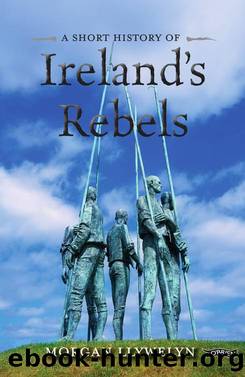A Short History of Ireland's Rebels by Morgan Llywelyn

Author:Morgan Llywelyn [Morgan Llywelyn]
Language: eng
Format: epub
ISBN: 9781847178282
Publisher: The O'Brien Press
Published: 2015-01-15T00:00:00+00:00
CHAPTER 12
Constance, Countess Markievicz (1868â1927)
âThe Rebel Countessâ
Constance Georgina Gore-Booth was born at Buckingham Gate, London. Her family were members of the Ascendancy, the landed Protestant class in Ireland. Among other properties, they owned Lissadell, an extensive estate in Sligo. Constance and her younger sister Eva Gore-Booth grew up in an atmosphere of wealth and privilege. William Butler Yeats was a frequent guest at their Sligo home, where he was inspired by the beauty of the two sisters to write one of his best-loved poems, âLissadellâ. As a girl, Constance fell in love with the vision of Gaelic Ireland which Yeatsâs poetry evoked.
When she was of age, Constance was duly presented at court. Considered one of the beauties of her season, she could be expected to continue to lead the pampered life of a young woman of her class, revolving around dressmakers and travel, society soirées in London and Dublin, long weekends at country houses enlivened by shooting parties and hunt balls, and eventually a brilliant marriage. Her husband would be wealthy, preferably titled â and unquestionably Protestant. With all the conventions satisfied, Constance would then retire into dignified matronhood and raise another family of aristocrats.
Instead she went off on her own to London and Paris to study art. A photograph taken during that time shows her smoking a cigarette and wearing knickerbockers that revealed her lower legs. This was only a foretaste of things to come.
When she was 30 and a confirmed spinster living in Paris, Constance fell in love with Count Casimir Markievicz. He was not wealthy, being a second son, and his title was one of courtesy only. Worse yet, from the Ascendancy point of view, he was a Roman Catholic. âCasiâ was also six years younger than Constance and married, with two sons, though he was estranged from his wife. In 1899 Casiâs wife died and Constance married him the next year.
Their only child, a daughter they named Maeve Alys, was born in 1901 at Lissadell. But Constance was neither wifely nor maternal by nature. Con, as her friends called her, showed a tendency to go her own way. Her husband referred to her as âmy loose cannonâ. She had many enthusiasms and felt passionately about equality and womenâs suffrage. Invited to a meeting to discuss the establishment of a journal for women, she came straight from a dinner at Dublin Castle, still attired in her ball gown, and promptly offered to sell her jewellery to finance the project.
The womenâs movement in Ireland was not only supportive of suffrage, but nationalistic. Con joined the Sinn Féin party and further dismayed Ascendancy friends by becoming active in InghÃnidhe na hÃireann and a regular contributor to the journal, Bean na hÃireann. Her Irish nationalism was becoming ever more apparent. In 1909 she helped to found Na Fianna Ãireann, an organisation inspired by the boy scout movement in England. Conâs Fianna were considerably more militant, however. A veteran of Big House shooting parties, Con taught them to shoot with a deadly accuracy they would put to good use later.
Download
This site does not store any files on its server. We only index and link to content provided by other sites. Please contact the content providers to delete copyright contents if any and email us, we'll remove relevant links or contents immediately.
Fanny Burney by Claire Harman(26250)
Empire of the Sikhs by Patwant Singh(22774)
Out of India by Michael Foss(16695)
Leonardo da Vinci by Walter Isaacson(12812)
Small Great Things by Jodi Picoult(6691)
The Six Wives Of Henry VIII (WOMEN IN HISTORY) by Fraser Antonia(5242)
The Wind in My Hair by Masih Alinejad(4850)
The Crown by Robert Lacey(4578)
The Lonely City by Olivia Laing(4575)
A Higher Loyalty: Truth, Lies, and Leadership by James Comey(4560)
The Iron Duke by The Iron Duke(4126)
Millionaire: The Philanderer, Gambler, and Duelist Who Invented Modern Finance by Janet Gleeson(4113)
Papillon (English) by Henri Charrière(3918)
Sticky Fingers by Joe Hagan(3916)
Joan of Arc by Mary Gordon(3792)
Alive: The Story of the Andes Survivors by Piers Paul Read(3739)
Stalin by Stephen Kotkin(3731)
Aleister Crowley: The Biography by Tobias Churton(3430)
Ants Among Elephants by Sujatha Gidla(3282)
